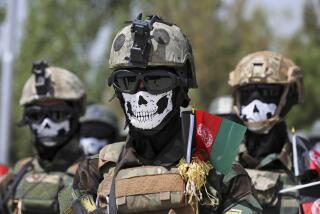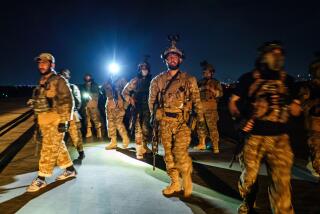Missions Will Grow More Dangerous for U.S. Troops
- Share via
WASHINGTON — The U.S. military used its long reach Sunday to land roundhouse punches on the terrorist network in Afghanistan. The dirtier and more dangerous rounds lie ahead, when the fighting becomes up close and personal.
Although Pentagon leaders said no Americans were lost in the first bombing raids, President Bush and Defense Secretary Donald H. Rumsfeld seemed resigned to losing Americans in the later stages of the open-ended war, when troops are expected to be sent in to root terrorists out of Afghanistan’s caves and crannies. Unlike President Clinton’s efforts to stop ethnic cleansing in Kosovo, Bush has indicated he is willing to put American troops on the ground in Afghanistan.
Special operations commandos, which include Green Berets and the elite Delta Force, are positioned to go into Afghanistan and may already be there, along with British Special Air Services commandos.
The basic mission of Green Beret A-teams, usually numbering from eight to 12 men, is to find the bad guys--and leave it to others to kill them. Green Beret officers keep reminding their macho troops that their job is to sneak in and sneak out, not to charge bunkers like a bunch of John Waynes.
An early mission for the A-teams is likely to be the establishment of communications posts inside Afghanistan. Later they may be deployed to locate trails used by the Taliban and throw across them natural-looking rocks hiding homing beacons. Bombers can then target the beacons when heat-seeking devices or spies signal that Taliban troops are on the move.
One big worry of retired Maj. Gen. James Guest, a former commander of the Army’s Green Berets, is what might happen if the Taliban captures a Green Beret. Guest says terrorists have tortured Russian prisoners--sometimes skinning them alive and sending videotapes of the horror to the victims’ hometowns. What, Guest asks, would happen to public support for this war if tapes of Americans being tortured were shown on television?
Rather than taking this risk, Guest says, he favors hiring latter-day versions of the “Dirty Dozen”--Afghans who know the language and territory--to find the enemy in the mountains where so many Soviets died during the invasion of 1979.
During the Persian Gulf War, U.S. and British commandos slipped into Iraq to try to find Scud missiles. No U.S. team found any, but the British did--by driving up and down Iraqi roads in Toyotas commonly driven by Iraqis. When the British commandos spotted a Scud being transported, they followed it to its launching location and radioed in the coordinates for bombers. In contrast, several Green Beret teams were discovered and had to be rescued by helicopter as armed civilians closed in on them.
If conventional light infantry troops follow unconventional commandos into Afghanistan, the experience of the Marine Corps indicates they will be at high risk when they try to enter caves suspected of concealing Taliban troops.
The Marine Corps has found in its exercises in city warfare that any unit suffers high casualties when it tries to enter a door or window because the enemy has the entrance covered from hidden positions.
Former Marine Corps Commandant Charles C. Krulak, talking about rooting an enemy out of a confined area, said simply, “It ain’t easy.”
More to Read
Sign up for Essential California
The most important California stories and recommendations in your inbox every morning.
You may occasionally receive promotional content from the Los Angeles Times.













